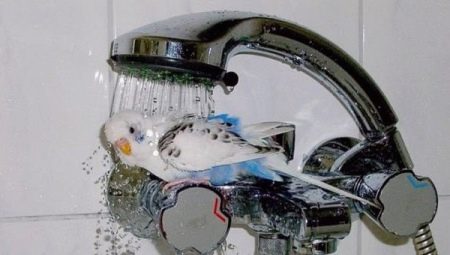The budgerigar is a fun, chatty, agile bird. For home content is considered ideal. These slender beautiful birds with elegant plumage constantly participate in international exhibitions of decorative birds, where prizes are often awarded to them. Caring for wavy is not so difficult. One element of care is swimming.
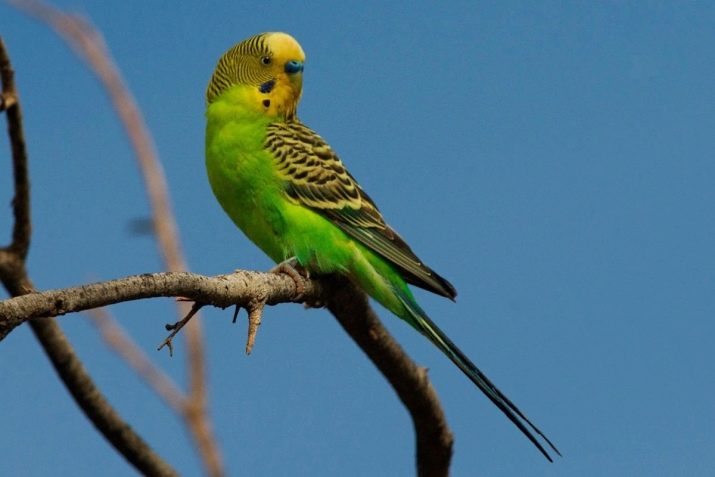
Such pets live in many Russian families, successfully adapt to the microclimate of apartments and actively breed in captivity.
rules
Budgerigars are naturally clean birds, so bathing birds is not only fun and entertaining, but also a necessary hygiene procedure. They perfectly know how to clean feathers themselves. To bathe a feathered bird is to refresh it with a little water. In nature, parrots bathe in dew drops on the grass, and this is enough. In order not to harm the health of the pet, you need to follow simple rules:
- You can begin to accustom a parrot to water procedures only after full adaptation to the new habitat (not earlier than a month after purchase), when the pet is already well tamed;
- you can not force the bird to swim, it will become very stressful, cause fear of water and undermine confidence;
- the light in the room should be scattered, so the parrot will be calmer (bright lighting annoys birds);
- for swimming, take only pure warm water without chlorine (bottled or filtered, as an option - settled), the parrot can swallow water when bathing during fun games with water;
- it is allowed to add chamomile decoction to the water, this improves digestion and skin condition;
- the room should be warm (at least +20 degrees), all windows are closed and the split system is turned off so that the pet does not catch a cold in the drafts;
- do not draw a lot of water into the tank, the optimal level in the bath is 1.5 - 2 cm;
- do not use a hair dryer for drying after bathing, this greatly drains the plumage of birds and adversely affects the skin;
- remove the water tank from the cage after bathing so that the bird cannot drink dirty water.
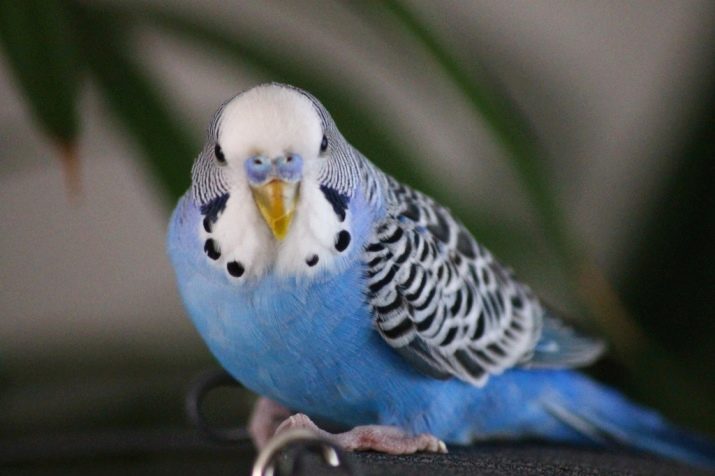
The term “bathing” for budgies does not mean that detergents must be applied to their plumage, immersed in water and rubbed with a washcloth.
Preparation
The owner knows the nature of his pet, his favorite toys and taste preferences in the feed.
At home, it is important to properly prepare the bird and take maximum care of positive emotions when meeting with water. How the bird will relate to water procedures in the future, to a large extent depends on how it was possible to bathe him for the first time. If the parrot is interested, swimming will become a pleasant, integral part of his life.
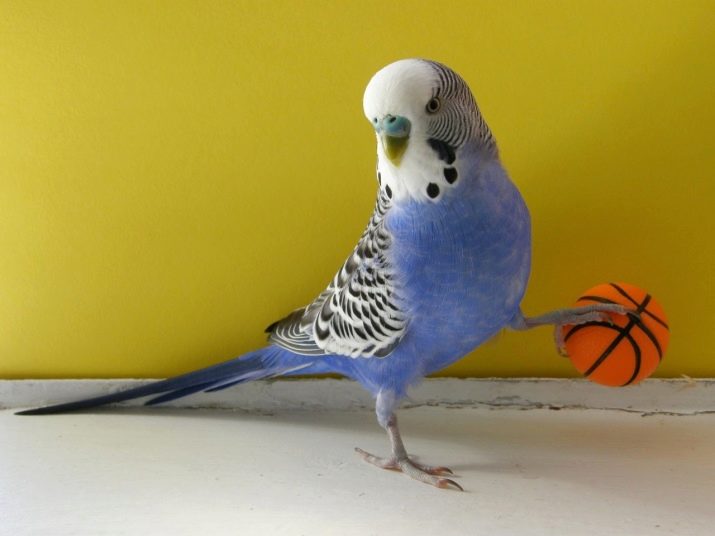
By the beginning of bathing, the parrot should be well tamed, a special bath-bath should be bought, there is a coarse atomizer, and a regular table lamp has been prepared.
Be sure to take into account the mood of the bird. If the parrot is "out of sorts," it is better to postpone the start of bathing. Accessories are important too. Often, for unknown reasons, the bird rejects beautiful, comfortable bathing suits and stubbornly prefers a nondescript saucer or a simple plastic lid from a glass jar. In such situations, it is better to come to terms with the choice of a pet and not insist, because it will be much more comfortable for him to use his favorite little thing than a branded bathing suit.
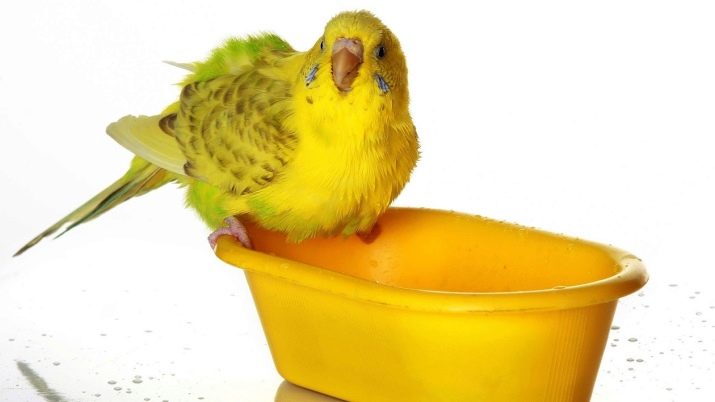
From a strong fear, a bird may have a fear of water, then you will have to abandon water procedures for a long time, if not forever.
Preparation
The feathered bird will observe how sparkling droplets from the bathing house spray the fingers of the owner, and he will understand that it is safe and fun. If the parrot stubbornly does not want to get acquainted with water, you can start with an empty bathing place in which to put your favorite toy, a delicious treat, fresh greens. In some cases, the beginning of bathing is facilitated by a mirror placed next to the bathing suit. The feathered one will see his reflection in the mirror and decide that he is not alone here. Together, swimming is more interesting, and the parrot will decide to enter the water.
You should not rush and push the parrot to the bathing place, you need to be patient and wait until he voluntarily starts to drop into the bathtub for what lies there. When this happens, you can add a little water to the bathhouse, starting with a scanty amount, gradually increasing the dose. The feathered one will not notice how he gets used to it and begins to spray water on himself.

It is good to arouse interest in water in a parrot, if you apply the elements of the game.
For every attempt to play with water, you need to encourage him with your favorite "snacks."
You can put a hand parrot on your hand and bring it to a stream of water, quietly running from an open tap. You can put the wavy on your shoulder, go wash your hands with it and specially hold them under a water stream, rubbing it calmly. Some "daredevils" themselves jump into the sink and begin to play with a trickle. The owner of such a bird is very lucky - to accustom him to the water is not difficult.
Some take pets with them to the shower room, and many parrots like to bathe with their host. But if the wavy is not enthusiastic about such a procedure, do not force him to stay in the soul for the whim of the owner, let him bathe as he chooses.
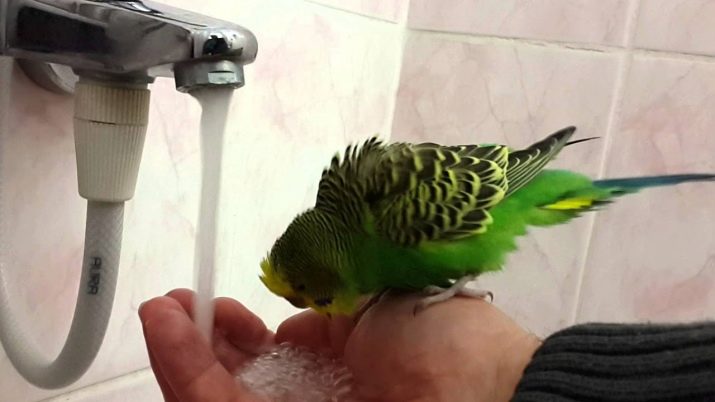
Do not substitute it under the stream, let it get used to the sounds of pouring water gradually.
Step-by-step instruction
Before swimming, you need to pay attention to the behavior of the parrot.If the pet does not have a completely healthy appearance, it is alarmed by something, tweeting loudly and rushing restlessly around the cage; you should not offer a bath at this moment.
There is more than one way to swim budgies. The specific choice depends on the nature of the bird and the preferences of the owner.
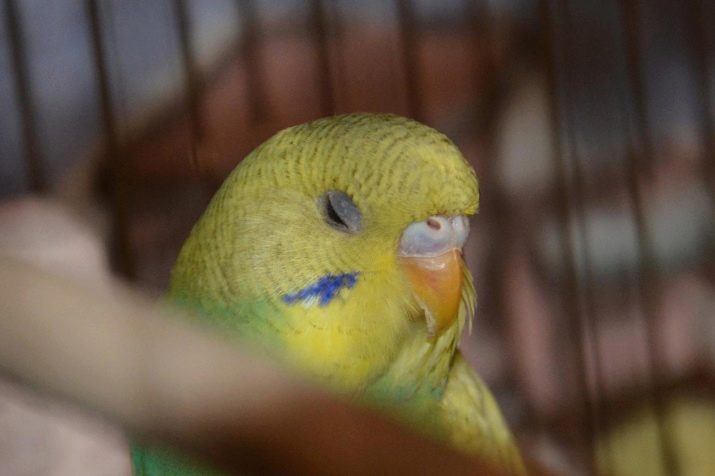
For example, consider how to bathe a bird in a bath:
- prepare a towel, hang on a heated towel rail (so it will be warm);
- grab the wavy with the thumb and forefinger just above the cheeks (the remaining fingers hold the bird's body) and lower it to the bottom of the empty bath without letting go of the hand;
- open the tap a little, the trickle of water should be thin so that the parrot does not get scared;
- adjust the temperature of the current jet;
- while holding the bird with one hand, gently rinse it with a weak water stream;
- close the water;
- set the pet on a warm towel and pat the feathers slightly;
- put in a cage.
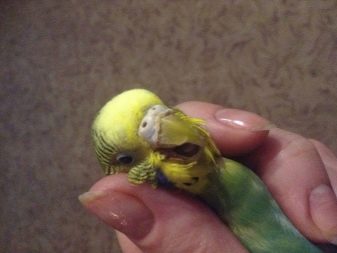
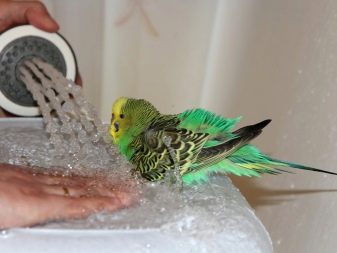
If he is actively interested in water in a drinking bowl, tries to spray on himself, spreads ruffled feathers - he is ready for water procedures.
This method of bathing wavy ornithologists consider the most preferable. If, due to an oversight, the parrot is very dirty, and the pollution cannot be washed off with clean water, you can use a specialized shampoo for birds (sold at pet stores). If part of the pollution still remains on the feathers, these feathers must be carefully trimmed.
Possible mistakes
If you ignore the basic rules for bathing budgies, problems can arise.
Here are the most common ones.
- Haste in teaching a bird to water procedures. Spontaneous actions must not be allowed; it is extremely difficult to correct negative results.
- Lack of attention to indoor conditions. As a result, the bird catches a cold in a draft. At the first sign of a cold, urgent veterinary care will be required.
- Water in the sinuses of the bird. If such a mistake could not be avoided, you must carefully hold the pet upside down for a short time, no more than 10 seconds.

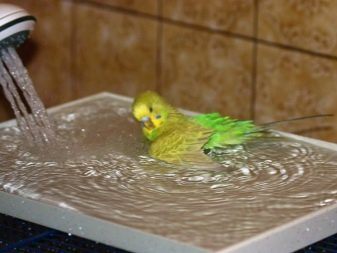
It is necessary to apply the product along the plumage and carefully rinse it several times so that when cleaning the feathers the bird does not become poisoned by the remnants of the detergent.
Alternative methods
You can bathe a parrot not only with the help of a bathing suit.
Atomizer
This is an easy way to swim, but to observe some rules yet is necessary:
- if the pet is very shy, it is better not to use a spray gun;
- the spray gun should not spray water too finely, coarse-grained models bring the procedure closer to natural bathing in the rain in natural conditions;
- the water in the spray bottle should be warmer than with ordinary bathing, it cools quickly when sprayed;
- at the time of bathing, remove the feeder from the cage;
- spray water not on the parrot, but above his head at a distance of about 30 cm, so that drops of water flow down onto the bird from above;
- bathing time 10-15 minutes, but if the bird likes it, you can extend it;
- after the procedure, you can turn on a regular table lamp and put a cage under it to warm a little the parrot and dry the plumage.
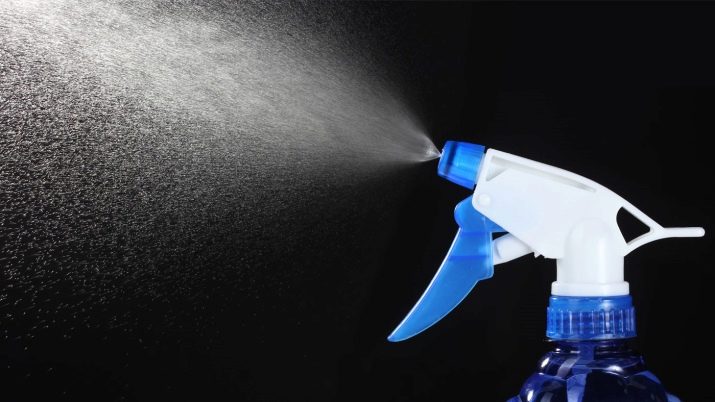
Wet greens
This is the closest method to natural conditions. The budgie rubs against wet lettuce leaves and stalks of grass, while the feathers are moistened with drops of moisture and cleaned. This is how wild parrots bathe in the dew on plants. If desired, the pet can peck tasty herbs and healthy salad.
Soft fresh weed or lettuce leaves are thoroughly washed and put in a bathing suit.
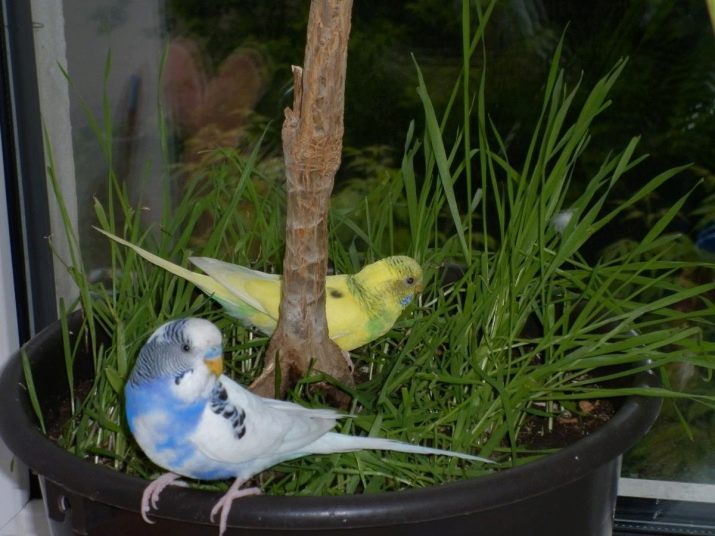
Fortified sand
This method is often used in winter, when the apartments are not warm enough, and swimming with water is impossible. Most birds with pleasure clean feathers in sand baths, thereby ensuring the hygiene of plumage and skin. Such sand is sold in pet stores. Plain river sand is not recommended, as it may contain unwanted “neighbors” (larvae, microbes, debris).
If the parrot is panicky afraid of water and cannot be taught to swim in any way, a small layer (up to 1 cm) of special fortified sand is poured into the bathtub and put your favorite toys.
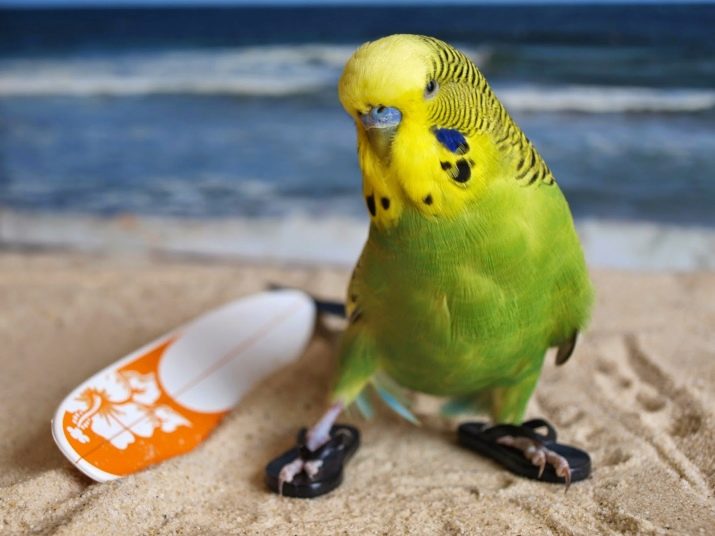
Talc
Talc-based baby powder is carefully applied to the plumage, and then removed with paper towels or a towel, along with dusting, feathers are removed from the feathers. It should be noted that ornithologists prefer hygiene using water. Owners of budgies need to make every effort and try so that the pet eventually considers the water procedures to be fun games and enthusiastically awaits them when he sees the owner's preparations for swimming.
The recommended average bathing frequency is once a month in winter and once a week in summer.
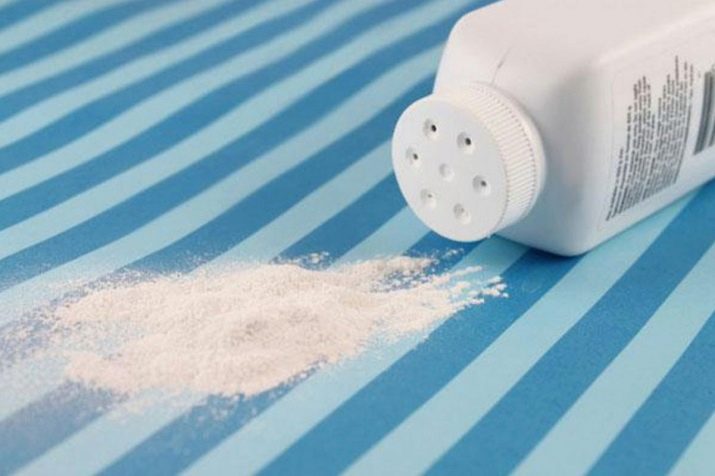
Among the wavy there are those who come from bathing in an indescribable delight. They can be bathed more often, especially in the hot summer time, this will help protect the bird from heat stroke as much as possible.
If you treat your pet kindly and patiently, you can quickly teach him to splash around in warm watere. A wavy will certainly fall in love with fun games with water and will enjoy swimming, giving the owner a lot of fun minutes in the company of a feathered friend, because watching a splashing budgie is a pure positive.
How to bathe the budgie, see below.
